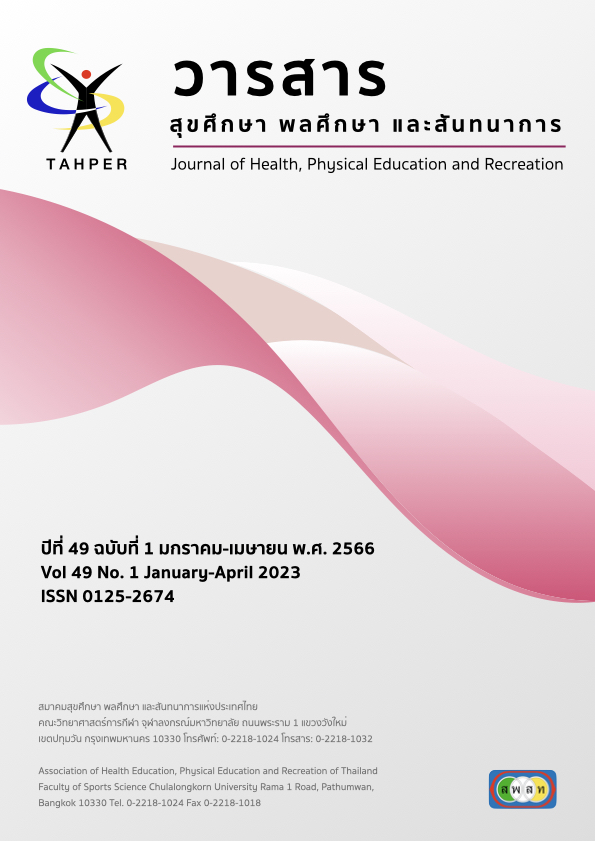The Relationship of Knowledge, Attitude and Behavior on 3E’S Health Care Principle of Overweight Adolescent in Bangkok
Main Article Content
Abstract
Purpose This study aims to study and relationship among knowledge, attitude and behavior on 3E's health care principle of overweight adolescent in Bangkok.
Methods This research was a descriptive study. Sample sizes consisted of 400 Thai adolescent, both male and female, between 12 and 14 who lived in Bangkok. A questionnaire, created by the researcher, was used as a research tool. The content validity was tested by expert panel judges and showed 0.85 and demonstrated acceptable reliability at 0.79. Data were analyzed by percentile, mean, standard deviation, t-test, F-test, and multiple comparisons by using Scheffe's method and set P-value at the 0.05 level. The relationship between media exposure, knowledge, attitude and behavior in obesity prevention was examined by Pearson's Product Moment Correlation Coefficient.
Results The results of this study were as follows:
- There was no relationship between knowledge and attitude on 3E's health care principle but there was a significant relationship between attitude and behavior (p<05), the correlation coefficient was in the low level (0.23).
- The knowledge and behavior of Thai adolescent people on 3E's health care principle showed a moderate level while attitude showed a high level.
Conclusion There was no relationship between knowledge and attitude on 3E's health care principle but there was a significant relationship between attitude and behavior (p<0.05), the correlation coefficient was in the low level (0.23).
Article Details

This work is licensed under a Creative Commons Attribution-NonCommercial-NoDerivatives 4.0 International License.
Critical thinking in journals is the right of the author. The Association of Health Education, Physical Education and Recreation of Thailand is not always required, to create diversity in ideas and creativity.
ความคิด ข้อวิพากษ์ในวารสารเป้นสิทธิของผู้เขียน สมาคมสุขศึกษา พลศึกษา และสันทนาการแห่งประเทศไทยไม่จำเป็นต้องเห็นชอบด้วยเสมอไป เพื่อให้เกิดความหลากหลายในความคิดและความสร้างสรรค์
References
กองโภชนาการ กรมอนามัย. (2542). แนวทางการประเมินผลกระทบต่อสุขภาพ จากโครงการพัฒนาแหล่งน้ำ : ด้านโภชนาการ. กรุงเทพฯ: ม.ป.พ.
จิราภรณ์ เรืองยิ่ง. (2559). พฤติกรรมการบริโภคอาหารของวัยรุ่นในจังหวัดสงขลา: การสังเคราะห์องค์ความรู้และปัจจัยที่มีอิทธิพลต่อพฤติกรรมการบริโภค อาหาร (รายงานผลการวิจัย). กรุงเทพฯ: สาขาการวิจัยพฤติกรรมศาสตร์ ประยุกต์ มหาวิทยาลัยศรีนครินทรวิโรฒ.
ทัศนา ศิริโชติ. (2557). รายงานการวิจัย ความรู้ ทัศนคติ และพฤติกรรมการบริโภคอาหารของนักศึกษา มหาวิทยาลัยราชภัฏสงขลา. สงขลา: คณะวิทยาศาสตร์และเทคโนโลยี มหาวิทยาลัยราชภัฏสงขลา.
นริสรา พึ่งโพธิ์สภ. (2552). ภาวะโภชนาการเกินหรือภาวะอ้วน. วารสารประชากรศาสตร์,18(2), 69-87.
Lobstein, T., Jackson-Leach, R., Moodie, M.L., Hall, K. D., Gortmaker, S.L. and Swinburn, B. A. (2015). Child and adolescent obesity: part of a bigger 377 picture. Lancet, 385, 2510–2520.
ประคอง กรรณสูต. (2542). สถิติเพื่อการวิจัยทางพฤติกรรมศาสตร์. กรุงเทพฯ: จุฬาลงกรณ์มหาวิทยาลัย.
พัชราภัณฑ์ ไชยสังข์, ปัญจภรณ์ ยะเกษม, และนุชจรีรัตน์ ชูทองรัตน์. (2557). ปัจจัยทำนายพฤติกรรมการบริโภคอาหารของนักเรียนชั้นประถมศึกษาปีที่ 4 -6 ที่มีน้ำหนักเกินเกณฑ์. วารสารวิทยาลัยพยาบาลบรมราชชนนี นครราชสีมา, 20(1), 30-43.
วารินทร์ มากสวัสดิ์. (2558). ความสัมพันธ์ระหว่างการรับรู้ความสามารถแห่งตนกับการมีกิจกรรมทางกายของวัยรุ่นตอนต้นที่มีภาวะน้ำหนักเกินในกรุงเทพมหานคร (วิทยาศาสตรมหาบัณฑิต). กรุงเทพฯ: สาขาวิชาวิทยาศาสตร์การกีฬา, จุฬาลงกรณ์มหาวิทยาลัย.
สำนักงานกองทุนสนับสนุนการสร้างเสริมสุขภาพ. (2551). สธ แนะยึด 3 อ. ช่วยลดพุง. สืบค้นเมื่อ 8 สิงหาคม 2560, จาก http://www.thaihealth.or.th/node/6108.
สํานักงานกองทุนสนับสนุนการสร้างเสริมสุขภาพ. (2557). คนไทยเป็นโรคอ้วนอันดับ 2 ของอาเซียน. สืบค้นเมื่อ 8 สิงหาคม 2560, จาก https://www.thaihealth.or.th/Content/24745-คนไทยเป็นโรคอ้วนอันดับ%202%20ของอาเซียน.html
สำนักงานสำรวจสุขภาพประชาชนไทย. (2552). การสำรวจสุขภาพประชาชนไทยโดยการตรวจร่างกายครั้งที่ 4 พ.ศ.2551-2552. กรุงเทพฯ: ม.ป.พ.
Karnik S, Kanekar A. (2012). Childhood obesity: a global public health crisis. Int J Prev Med, 3(1): 1-7.
Mo-suwan. (2009). The Fourth National Healthexamination survey, 2008-2009. Report: Children’s health. In: Aekplakorn W, editor. Capter 8 Nutritional status of children. Nonthaburi. (in Thai)
Mo-suwan L. (2011). Obesity and abdominal obesity in children and adolescents. In: Nitiyanant W, editor. Obesity and abdominal obesity. Bangkok: Sukhumvit Media Marketing. p. 57-70. (in Thai)
Pulgaron ER. (2013). Childhood obesity: a review of increased risk for physical and psychological comorbidities. Clin Ther, 35(1), A18-32
World Health Organization. (2011). Obesity and overweight. Retrieved June 12, 2015. From http://www.who.int/mediacentre/factsheets/fs311/en/index.html


